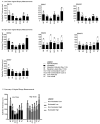A combined oral contraceptive affects mucosal SHIV susceptibility factors in a pigtail macaque (Macaca nemestrina) model
- PMID: 25536296
- PMCID: PMC4355188
- DOI: 10.1111/jmp.12157
A combined oral contraceptive affects mucosal SHIV susceptibility factors in a pigtail macaque (Macaca nemestrina) model
Abstract
Background: Injectable hormonal contraception may increase women's risk of HIV acquisition and can affect biological risk factors in animal models of HIV. We established, for the first time, a model to investigate whether combined oral contraceptives (COC) alter SHIV susceptibility in macaques.
Methods: Seven pigtail macaques were administered a monophasic levonorgestrel (LNG)/ethinyl estradiol (EE) COC at 33% or 66% of the human dose for 60 days. Menstrual cycling, vaginal epithelial thickness, and other SHIV susceptibility factors were monitored for a mean of 18 weeks.
Results: Mean vaginal epithelial thicknesses were 290.8 μm at baseline and 186.2 μm during COC (P = 0.0141, Mann-Whitney U-test). Vaginal pH decreased from 8.5 during treatment to 6.5 post-treatment (0.0176 two-tailed t-test). Measured microflora was unchanged.
Conclusions: COC caused thinning of the vaginal epithelium and vaginal pH changes, which may increase SHIV susceptibility. 0.033 mg LNG + .0066 mg EE appeared effective in suppressing ovulation.
Keywords: SHIV; contraception; non-human primate (NHP); susceptibility; transmission risk.
Published 2014. This article is a U.S. Government work and is in the public domain in the USA.
Figures





Similar articles
-
Relationship of Estimated SHIV Acquisition Time Points During the Menstrual Cycle and Thinning of Vaginal Epithelial Layers in Pigtail Macaques.Sex Transm Dis. 2015 Dec;42(12):694-701. doi: 10.1097/OLQ.0000000000000367. Sex Transm Dis. 2015. PMID: 26562699 Free PMC article.
-
Progestin-based contraception regimens modulate expression of putative HIV risk factors in the vaginal epithelium of pig-tailed Macaques.Am J Reprod Immunol. 2018 Oct;80(4):e13029. doi: 10.1111/aji.13029. Epub 2018 Aug 3. Am J Reprod Immunol. 2018. PMID: 30076667
-
Analysis of putative mucosal SHIV susceptibility factors during repeated DMPA treatments in pigtail macaques.J Med Primatol. 2015 Oct;44(5):286-95. doi: 10.1111/jmp.12188. Epub 2015 Aug 4. J Med Primatol. 2015. PMID: 26238265
-
Comparison of the vaginal environment of Macaca mulatta and Macaca nemestrina throughout the menstrual cycle.Am J Reprod Immunol. 2014 Apr;71(4):322-9. doi: 10.1111/aji.12201. Epub 2014 Feb 13. Am J Reprod Immunol. 2014. PMID: 24521395 Free PMC article. Review.
-
[Individualization of low-dose oral contraceptives. Pharmacological principles and practical indications for oral contraceptives].Minerva Ginecol. 2007 Aug;59(4):415-25. Minerva Ginecol. 2007. PMID: 17923832 Review. Italian.
Cited by
-
Systems Analysis Reveals Contraceptive-Induced Alteration of Cervicovaginal Gene Expression in a Randomized Trial.Front Reprod Health. 2022 Mar 3;4:781687. doi: 10.3389/frph.2022.781687. eCollection 2022. Front Reprod Health. 2022. PMID: 36303659 Free PMC article.
-
Hormonal Contraception and HIV-1 Acquisition: Biological Mechanisms.Endocr Rev. 2018 Feb 1;39(1):36-78. doi: 10.1210/er.2017-00103. Endocr Rev. 2018. PMID: 29309550 Free PMC article. Review.
-
A Novel Microbicide/Contraceptive Intravaginal Ring Protects Macaque Genital Mucosa against SHIV-RT Infection Ex Vivo.PLoS One. 2016 Jul 18;11(7):e0159332. doi: 10.1371/journal.pone.0159332. eCollection 2016. PLoS One. 2016. PMID: 27428377 Free PMC article.
-
Relationship of Estimated SHIV Acquisition Time Points During the Menstrual Cycle and Thinning of Vaginal Epithelial Layers in Pigtail Macaques.Sex Transm Dis. 2015 Dec;42(12):694-701. doi: 10.1097/OLQ.0000000000000367. Sex Transm Dis. 2015. PMID: 26562699 Free PMC article.
References
-
- Polis CB, Curtis KM. Use of hormonal contraceptives and HIV acquisition in women: a systematic review of the epidemiological evidence. Lancet Infect Dis. 2013;13(9):797–808. - PubMed
-
- Sodora DL, et al. Vaginal transmission of SIV: assessing infectivity and hormonal influences in macaques inoculated with cell-free and cell-associated viral stocks. AIDS Res Hum Retroviruses. 1998;14(Suppl 1):S119–23. - PubMed
Publication types
MeSH terms
Substances
Grants and funding
LinkOut - more resources
Full Text Sources
Other Literature Sources
Medical

